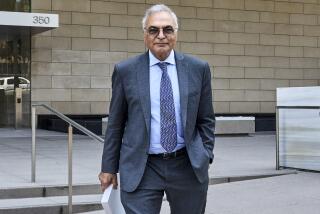New Implant Surgery Gives Hearing Back to the Deaf
- Share via
Doctors have implanted a fascinating new device into the ear of a San Diego resident, restoring to a major extent that person’s ability to hear normally after years of total deafness, it was announced Monday by the UC San Diego Medical Center.
The procedure was carried out Jan. 3 at the medical center under a joint program between the facility and the Veterans Administration Hospital in La Jolla. About 50 such operations have been performed worldwide.
“It’s amazing the improvements that can be seen,” said Dr. Terence Davidson of the UCSD center’s head and neck surgery division. Davidson and Dr. Jeffrey Harris carried out the procedure.
“I’ve seen videotapes of four women who had the procedure who were sitting around talking just like four hens on a post, just like at any women’s tea, the way they carried on,” Davidson told The Times. The range of hearing restoration depends on the individual, but in some cases patients have been able to hear without need of lip-reading or a hearing aid even when using the telephone.
Deafness is frequently caused by inner ear damage, the snail-like organ vital to sound. However, nerve fibers that transmit sound from the ear to the brain often remain healthy. And those nerve fibers are key to using the new device--an Australian product called a cochlear implant--to restore hearing.
In essence, the procedure consists of placing five parts, three of which are worn outside the body and two placed inside. A tiny microphone and transmitter are worn on a headband and a signal processor is placed in a pocket. They pick up, amplify and filter sounds and send them to a small receiver implanted in the mastoid bone behind the ear, just under the skin.
A platinum electrode is then surgically implanted in the inner ear, where it receives signals from the receiver, and then like a generator fires off impulses through the nerve fibers to the brain, where the person hears them as sound.
While the sound may first seem as noise to the patient, fine tuning through programming the processor leads to recognition of words and tones within several weeks, Davidson said.
The beauty of the platinum electrode, according to Davidson, is in its 22 tone channels, which foster creativity by allowing a wide variety of sounds and patterns to be recognized. “Single channel implants were the first, but they made people aware mainly only of noise, because there was only one tone that you could turn on and off,” Davidson said. “But this new device is fascinating in that you can have a person talking normally three weeks later.”
In the fine tuning following the surgery, physicians hook up the patient’s processor to a diagnostic system which can program the processor to select the sounds and patterns most useful for the patient to interpret what is being heard. That program is based on pulse rates, comfort levels, pitch and loudness.
“We want persons who had hearing once before it was lost so they do have language training,” Davidson said. “There are about 500,000 people nationwide with that kind of hearing loss.” Such a loss can result from diseases where spongy bone forms in the ear, from a disease that causes dizziness and deafness, and from the effects of infections such as meningitis or from drug toxicity.
Patients eligible for the implant are tested to determine their ability to transmit signals.





